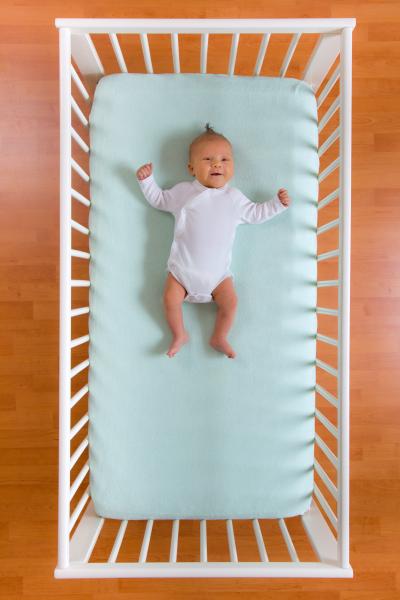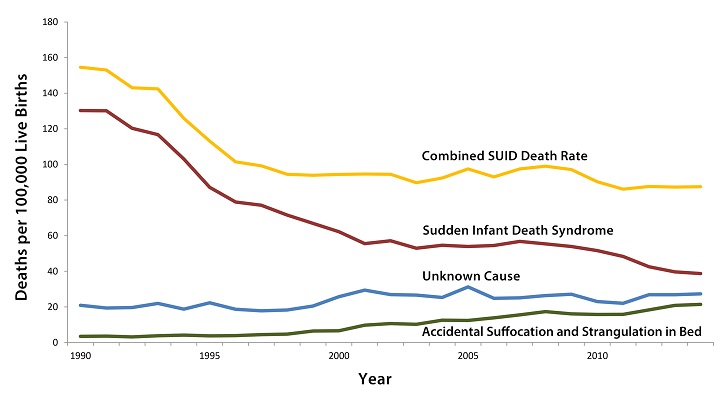
Sudden infant death syndrome (SIDS) falls into a larger category of "sudden uncategorized infant deaths" (SUID) alongside 'accidental suffocation and strangulation in bed' and those of 'unknown cause.'
These deaths are defined as the sudden death of an infant less than one year of age that have no immediately obvious cause and can be caused by suffocation, asphyxia, entrapment, infection, ingestions, metabolic disease, congenital heart conditions and trauma (either intentional or unintentional.)
Although SIDS remains a black box in many ways, there is a model that explains, in part, how it happens and how risk can be minimized. The recommendations behind preventing SIDS take into account three different factors that, when aligned, may result in death of the infant. The first of those factors is a "stressful" environment created by sleeping on the stomach, overheating due to too many clothes/blankets, or obstruction of the airway. The second factor is the early stage of development of the infant and the third is referred to as 'intrinsic vulnerability' and is most easily described as a lack of ability to awake due to some factor - genetic or otherwise.
The rate of SIDS deaths started to fall in the early 1990s with the implementation of the "Back to Sleep" campaign (now known as the "safe to sleep" campaign.) However, those rates have hit a plateau in more recent years - note the yellow line after about 1998 in the chart below. (www.cdc.gov/sids/data.htm.)

With that, the American Academy of Pediatrics is working to advance the information that is being given to new parents regarding how best to keep their baby safe. To that end, they have released new SIDS recommendations, for the first time in five years, that are more complete than ever. The new advice is specific to deaths that occur during sleep and offer context in how to set up the best possible sleeping environment.
The old standards are still on the list and should, after 15 years, be common knowledge by now. The "face up to wake up" slogan is perhaps the most notorious recommendation, referring to how babies should be put down to sleep - on their backs. Also, a firm sleep surface with no bumpers, pillows, blankets or stuffed animals is another key to SIDS prevention that has been around for years.
Some of the additional recommendations are worth noting - in particular the comment that couches and armchairs are an incredibly dangerous place to fall asleep with an infant - even more so than falling asleep in a bed with one. They state that the couch sleeping situation can easily result in suffocation through "entrapment or wedging between seat cushions," or that the adult could easily lay on top of the infant. Therefore, it is important to resist laying down on a couch with an infant, if you are feeling sleepy.
One of the most important sentences in the report, I think, is that a large percentage of infants who die of SIDS are found with their head covered by bedding. So, if you bring your infant into the bed for a night-time feeding, it is incredibly important to return them to their own bed once the feeding is over.
Another new recommendation is that preterm infants should be placed on their back as soon as possible which is especially important as preterm babies are at an increased risk of SIDS. Also, they note that once a baby can roll onto their stomach, it is acceptable to leave them in that position, however all babies under one year old should be placed on their backs to start the sleep. Additionally, car seats, strollers, swings, infant carriers, and infant slings, are not recommended for routine sleeping.
Another addition to the recommendations is that infants sleep in the parents' room, but not in the parents' bed, for up to a year, stating that the arrangement of sharing a room decreases the risk of SIDS by up to 50%, although this figure is contested.
And, the new recommendation with perhaps the least scientific backing is that pacifiers have a substantial protective effect against SIDS (even though no one knows why, so it seems a strange recommendation to make - it probably won't hurt to use one anyway.)
Although many of the new recommendations seem to fall short on scientific evidence to back them up, it is their collective pointing toward the same goal - creating a safe sleeping environment for an infant - that will hopefully move the needle forward. And, with thousands of SIDS deaths still occurring each year - each one as heartbreaking as the next - and very little understanding as to the underlying cause of the occurence, this is a challenging and important goal.
The entire list of recommendations can be found here - leveled into three categories, based on the amount of evidence behind them.
A-level recommendations
- Back to sleep for every sleep
- Use a firm sleep surface
- Breastfeeding is recommended
- Room-sharing with the infant on a separate sleep surface is recommended
- Keep soft objects and loose bedding away from the infant's sleep area
- Consider offering a pacifier at naptime and bedtime.
- Avoid smoke exposure during pregnancy and after birth.
- Avoid alcohol and illicit drug use during pregnancy and after birth.
- Avoid overheating
- Pregnant women should seek and obtain regular prenatal care
- Infants should be immunized in accordance with AAP and CDC recommendations
- Do not use home cardiorespiratory monitors as a strategy to reduce the risk of SIDS
- Health care providers, staff in newborn nurseries and NICUs, and child care providers should endorse and model the SIDS risk reduction recommendations from birth.
- Media and manufacturers should follow safe sleep guidelines in their messaging and advertising
- please see follow up article to be published later this week
- Continue the "Safe to Sleep" campaign, focusing on ways to reduce the risk of all sleep-related infant deaths, including SIDS, suffocation, and other unintentional deaths. Pediatricians and other primary care providers shuold actively participate in this campaign.
B-level recommendations
- Avoid the use of commercial devices that are inconsistent with safe sleep recommendations
- Supervised, awake tummy time is recommended to facilitate development and to minimize development of positional plagiocephaly
C-level recommendations
- Continue research and surveillance on the risk factors, causes, and pathophysiologic mechanisms of SIDS and other sleep-related infant deaths, with the ultimate goal of eliminating these deaths entirely.
- There is no evidence to recommend swaddling as a strategy to reduce the risk of SIDS
References:
2) http://pediatrics.aappublications.org/content/early/2016/10/20/peds.2016...



